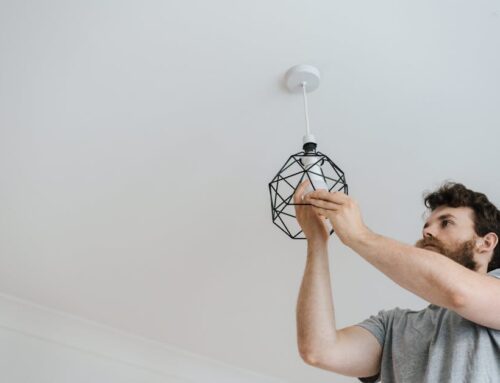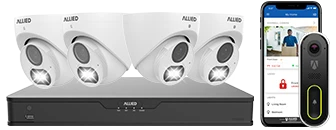Introduction to Home Monitoring Alarm Systems
Home monitoring alarm systems have become an integral component of modern residential security. These systems not only provide a crucial layer of protection against break-ins and burglaries but also offer peace of mind through 24/7 monitoring and emergency response services. With advancements in technology, home monitoring alarm systems now offer a wide array of features, ensuring comprehensive protection for your home and family.
The primary function of a home monitoring alarm system is to detect and deter unauthorized entry into your property. This is typically achieved through a combination of sensors, cameras, and alarms, all designed to alert homeowners and emergency services in case of suspicious activity. Today, these systems have evolved to include smart home integration, allowing users to control and monitor their security setup through smartphones and other internet-enabled devices.
For nearly three decades, Allied has been a trusted name in Texas for home security installation and alarm monitoring. Winning multiple awards for excellence, the company offers a range of options for smart home security systems and surveillance solutions. Allied’s security packages go beyond residential needs, extending services to small businesses and commercial enterprises. Each security package is comprehensive, encompassing police, medical, and fire alarm monitoring to ensure the utmost protection.
Allied’s security systems are designed with user convenience in mind, providing solutions that are both robust and flexible. Whether you are looking to secure a small apartment or a large commercial space, Allied offers limitless options that can be tailored to meet specific security requirements. The company prides itself on its unparalleled level of customer service, offering a price match guarantee and free same-day setup to ensure customers receive prompt and efficient service.
The affordability and quality of Allied’s services make them a superior choice for home security. With monthly monitoring starting as low as $19.95, Allied makes it financially feasible for every homeowner to invest in top-notch security. In addition, the company has strategically established its presence across major Texas cities including Houston, Dallas/Fort Worth, San Antonio, and Austin, ensuring accessible and reliable support for its customers.
Choosing the right home monitoring alarm system involves careful consideration of various factors such as the type of system, key features, cost, and provider reliability. As you embark on the journey to enhance your home’s security, it’s crucial to evaluate all available options to find a solution that offers the best combination of protection, convenience, and affordability.
Types of Home Monitoring Alarm Systems
The choice of a home monitoring alarm system depends largely on the type of system you opt for. Various types of home monitoring alarm systems cater to different security needs, preferences, and budgets.
Wired Alarm Systems
Wired alarm systems are traditional security solutions that use physical cables to connect sensors and devices to the control panel. These systems are known for their reliability and stable signals. They are less susceptible to interference and hacking compared to wireless systems. However, installation can be complex and might require professional assistance.
Wireless Alarm Systems
Wireless alarm systems use radio frequency signals to communicate between sensors and control panels. These systems are easier to install since they do not require extensive wiring. Additionally, they offer flexible placement of sensors and devices. The downside is their potential vulnerability to signal interference and hacking, although modern systems often include encryption technology to mitigate these risks.
Smart Alarm Systems
Smart alarm systems integrate with other smart home devices and can be controlled remotely through smartphones or tablets. These systems often feature additional functionalities such as real-time alerts, video surveillance, and automation. They are highly versatile but can be more expensive and may require a reliable internet connection to function optimally.
Self-Monitored Systems
Self-monitored systems alert the homeowner directly via notifications, SMS, or calls when an alarm is triggered. There is no monthly fee for professional monitoring, making it a cost-effective option. The main limitation is the reliance on the homeowner to respond promptly to alerts, which could be problematic if they are unavailable.
Professionally Monitored Systems
Professionally monitored systems send alerts to a monitoring center, where personnel assess the situation and contact emergency services if needed. These systems provide an added layer of security and peace of mind as they ensure a timely response. However, they usually involve monthly subscription fees, which can increase the overall cost.
Table: Comparison of Home Monitoring Alarm Systems
| Type | Key Characteristics |
|---|---|
| Wired Alarm Systems | Reliability, Stable Signal, Requires Professional Installation |
| Wireless Alarm Systems | Easy Installation, Flexible Placement, Potential Signal Interference |
| Smart Alarm Systems | Integration with Smart Devices, Remote Control, Higher Cost |
| Self-Monitored Systems | Cost-Effective, Direct Alerts, Relies on Homeowner’s Availability |
| Professionally Monitored Systems | 24/7 Monitoring, Timely Emergency Response, Monthly Fees |
Key Features to Consider
When choosing a home monitoring alarm system, it is essential to consider a range of features that can significantly impact the effectiveness and usability of the system. Recognizing these key features will help in selecting a system that best suits your needs.
1. Sensors: The core component of any alarm system is its sensors. These can include door and window sensors, motion detectors, glass break sensors, and environmental sensors such as smoke, fire, carbon monoxide, and flood sensors. Each type of sensor performs a specific role in detecting potential threats.
2. Central Monitoring: Central monitoring services connect your alarm system to a central station that monitors alerts 24/7. When an alarm is triggered, the monitoring center can verify the threat and dispatch emergency services if necessary. This feature provides an added layer of security and peace of mind.
3. Wireless Connectivity: Modern home monitoring systems often utilize wireless technology, making them easier to install without the need for extensive wiring. Wireless systems are also portable, allowing for easier relocation if you move homes.
4. Mobile Access and Remote Control: Many contemporary systems include smartphone apps or online portals that enable you to monitor and control your system remotely. This can include arming and disarming the system, receiving notifications, and viewing live camera feeds.
5. Integration with Smart Home Devices: Integration with smart home ecosystems such as Amazon Alexa, Google Home, and Apple HomeKit adds convenience and enhances the capabilities of your alarm system. This integration can enable voice control and automation features.
6. Video Surveillance: Incorporating cameras into your security setup allows for video monitoring both inside and outside your home. Features to look for include HD resolution, night vision, motion-triggered recording, and cloud storage for video footage.
7. Backup Power: A reliable home monitoring system should have a backup power option, typically in the form of battery backup, to ensure it remains operational during a power outage.
8. Professional Installation vs. DIY Options: Some systems require professional installation, which ensures all components are correctly set up, while others are designed for easy DIY installation. The best choice depends on your technical comfort level and the complexity of the system.
9. Customization and Scalability: The ability to customize your system with additional sensors, cameras, and other components is crucial. Scalability allows you to expand your system as your security needs evolve.
10. User Interface and Alerts: A user-friendly interface makes it easier to manage your system. Additionally, customizable alerts via text message, email, or push notifications keep you informed about any activity or issues with your system.
By weighing these features, homeowners can select a home monitoring alarm system that provides comprehensive protection tailored to their specific requirements.
Leading Home Monitoring Alarm System Providers
When selecting a home monitoring alarm system, understanding the leading providers in the market can help narrow down choices. The following are some of the most reputable providers known for their robust offerings and reliability in home security.
1. ADT: ADT is one of the oldest and most well-known alarm system providers in the industry. They offer a wide range of security packages that include intruder detection, fire and carbon monoxide monitoring, and smart home integration. ADT also provides professional installation services and 24/7 monitoring.
2. SimpliSafe: SimpliSafe is popular for its DIY installation and no-contract monitoring plans. Their systems are highly customizable, allowing users to choose the exact components they need. SimpliSafe systems are also noted for their ease of use and affordability.
3. Vivint: Vivint offers advanced smart home solutions integrated with their security systems. Features include professional installation, 24/
7 monitoring, and advanced automation options. Vivint’s systems are compatible with various smart home devices, providing comprehensive home control.
4. Frontpoint: Frontpoint emphasizes customer-friendly service and DIY installation. They offer a wide selection of equipment and monitoring plans. Frontpoint’s systems are known for their reliability and excellent customer support.
5. Ring: Ring, owned by Amazon, is known for its video doorbells and security cameras. Their alarm system offerings are designed for easy setup and integration with other Ring products and Amazon’s Alexa. No contract is required for their monitoring plans, making them a flexible option.
| Provider | Key Features |
|---|---|
| ADT | Professional installation, 24/7 monitoring, smart home integration |
| SimpliSafe | DIY installation, no-contract plans, customization options |
| Vivint | Smart home automation, professional installation, 24/7 monitoring |
| Frontpoint | DIY installation, reliable customer support, customizable packages |
| Ring | Video doorbells, DIY setup, no-contract monitoring |
Choosing the right home monitoring alarm system provider involves evaluating the specific needs of your home and weighing the features and services offered by each provider. By understanding what each leading company brings to the table, homeowners can make a more informed decision that best fits their security requirements.
Installation and Maintenance
Installing and maintaining a home monitoring alarm system is crucial to ensure its effectiveness and longevity. This chapter provides a comprehensive overview of the steps required for proper installation and ongoing maintenance of these systems.
Installation Process
The installation of a home monitoring alarm system typically involves several steps:
- Site Assessment: Before installation, a professional usually assesses the property to determine the best locations for sensors, cameras, and control panels.
- Equipment Setup: The actual setup involves placing sensors on windows, doors, and other entry points as well as installing cameras at strategic locations.
- System Configuration: Once the hardware is in place, the system is configured. This may include setting up the control panel, connecting devices to the central hub, and linking the system to a monitoring service if applicable.
- Network Integration: Many modern systems require integration with home networks. This generally involves connecting devices via Wi-Fi or Ethernet to enable remote monitoring and control.
- Testing: After installation, the system needs to be tested to ensure that all components are functioning correctly. This includes verifying sensor activation, alarm triggering, and communication with the monitoring service.
- User Training: Some providers offer training to ensure homeowners are familiar with operating the system, managing alerts, and contacting support if needed.
Maintenance
Regular maintenance is vital for ensuring the reliability and effectiveness of a home monitoring alarm system. Maintenance activities can include:
- Regular Testing: Periodically testing the system to ensure sensors, alarms, and cameras are working correctly.
- Software Updates: Keeping the system’s firmware and software up to date to protect against vulnerabilities and to benefit from new features.
- Battery Replacement: Ensuring that battery-operated components, such as sensors and control panels, have fresh batteries. Some systems provide alerts when batteries are low.
- Physical Inspection: Regularly inspecting the physical condition of all components to check for damage or wear and tear.
- Cleaning: Cameras and sensors should be cleaned to ensure they function properly. Dust and debris can obstruct sensors and impact the quality of camera footage.
Routine Checklist
Below is a routine maintenance checklist that homeowners can follow to ensure their home monitoring alarm system remains in optimal condition:
| Task | Frequency |
| Test system functionality | Monthly |
| Update software/firmware | As available |
| Replace batteries | Every 6-12 months |
| Inspect equipment for damage | Quarterly |
| Clean sensors and cameras | Monthly |
By following these installation and maintenance guidelines, homeowners can ensure their home monitoring alarm system provides reliable protection and peace of mind.
Costs and Budget Considerations
When selecting a home monitoring alarm system, it is crucial to understand the various costs involved and consider your budget constraints. The expense of a home monitoring alarm system can vary significantly based on numerous factors, such as the type of system, features, installation fees, and ongoing maintenance costs.
Initial Costs: The initial cost comprises the purchase price of the equipment and installation fees. Basic systems with fundamental features typically start at around $100, while more advanced systems with additional sensors and smart home integration can cost several hundred dollars. Professional installation might add another $100 to $250 to the overall cost, depending on the complexity of the setup.
Monthly Monitoring Fees: Many home monitoring alarm systems offer professional monitoring services, which typically require a monthly subscription fee. These fees can range from $10 to $50 per month. Professional monitoring ensures that emergency services are alerted when an alarm is triggered, providing an additional layer of security.
Note: Some providers offer self-monitoring options through mobile apps at a lower monthly cost or even for free, but these lack the added assurance of professional intervention.
Additional Costs: Beyond the basic and monthly costs, there are other potential expenses to keep in mind:
- Equipment Add-Ons: Additional sensors, cameras, or smart home devices can increase the overall cost. Each add-on can range from $20 to $200.
- Maintenance and Repairs: While most equipment comes with a warranty, you may incur costs for maintenance and out-of-warranty repairs. Routine maintenance might include battery replacement and sensor recalibration.
- Upgrades: As technology advances, you might want to upgrade your system for enhanced functionality, which can lead to additional expenses.
When considering your budget, it’s vital to account for all these associated costs to avoid unexpected financial burdens. It is also recommended to read the fine print of any service contracts for hidden fees or cancellation policies that might affect your budget in the long term.
By carefully evaluating all costs and budgeting accordingly, you can make an informed decision on the most appropriate home monitoring alarm system that meets your needs and financial situation.
User Experiences and Reviews
User Experiences and Reviews
User experiences and reviews are crucial in determining the effectiveness and reliability of a home monitoring alarm system. By analyzing feedback from actual users, potential buyers can gain insights into the performance, usability, and customer service quality of various systems.
Several reputable platforms provide a wealth of user reviews, including:
- Amazon: Amazon’s user reviews are comprehensive, covering a broad range of alarm systems available for purchase. Reviews often include ratings on ease of installation, reliability, and overall satisfaction.
- Best Buy: Best Buy’s website offers detailed reviews with a star rating system. These reviews often highlight specific features users liked or found lacking.
- Consumer Reports: Known for its in-depth and unbiased reviews, Consumer Reports offers ratings that consider multiple performance aspects and user feedback.
- Google Reviews: General user feedback on businesses and products, including home monitoring alarm systems, frequently appears in Google Reviews.
Common Themes in User Reviews
Analysis of user reviews reveals common themes that are important to prospective buyers:
- Ease of Installation: Many users stress the importance of straightforward installation. Systems that are user-friendly and come with clear instructions receive higher ratings.
- Reliability: The system’s ability to perform as advertised is a major point. Users often highlight whether or not their system effectively detected break-ins or other emergencies.
- Customer Support: Quality and responsiveness of customer service are frequently mentioned. Positive reviews often note helpful and timely customer service interactions.
- Mobile App Performance: For systems that include mobile apps, users commonly review the app’s functionality, reliability, and user interface.
- Value for Money: Cost-effectiveness is a subject of many reviews. Users compare the features offered against the price paid to determine overall value.
Representative Feedback
Overall, the feedback from users highlights the importance of understanding both the technical specifications and the user experience aspect of home monitoring alarm systems. Systems with seamless user experiences, reliable performance, and strong customer support invariably receive better reviews.
Future Trends in Home Monitoring Alarm Systems
8. Future Trends in Home Monitoring Alarm Systems
The home monitoring alarm systems market is continually evolving, driven by advancements in technology and changing consumer needs. Staying informed about upcoming trends can help homeowners make informed decisions when choosing a home monitoring system. Several key trends are expected to shape the future of home monitoring alarm systems.
Integration with Smart Home Devices
One significant trend is the increasing integration of home monitoring systems with smart home devices. This integration allows for enhanced control and automation, enabling homeowners to manage their security alongside other smart home functions such as lighting, heating, and appliances through a single platform.
AI and Machine Learning
Artificial intelligence (AI) and machine learning are becoming integral components of modern home security systems. These technologies improve the accuracy of threat detection by analyzing patterns and behaviors, thereby reducing the number of false alarms. They also enable predictive analytics, which can anticipate potential security breaches before they occur.
Enhanced Connectivity
The development of 5G technology is set to revolutionize home monitoring systems by providing faster, more reliable connectivity. Enhanced connectivity supports high-resolution video streaming and faster communication between devices, ensuring that homeowners receive real-time alerts and can respond swiftly to security incidents.
Cloud Storage and Remote Access
Cloud-based solutions are becoming more popular, offering homeowners the ability to store and access video footage remotely. This trend provides enhanced data security and easier access to historical data, which can be crucial in the event of an incident. Remote access also allows homeowners to monitor their property from anywhere in the world using a smartphone or computer.
Biometric Authentication
Biometric authentication methods, such as facial recognition and fingerprint scanning, are being incorporated into home monitoring systems. These methods provide a higher level of security by ensuring that only authorized individuals can access the premises. Biometric data is difficult to replicate, making it a robust solution for deterring unauthorized access.
Environmental Monitoring
Modern home monitoring systems are not limited to security alone; they also include environmental monitoring features, such as smoke detectors, carbon monoxide sensors, and water leak detectors. These features help protect homeowners from various hazards, ensuring a comprehensive approach to home safety.
Expanded Use of IoT Devices
The Internet of Things (IoT) is playing a pivotal role in the development of home monitoring systems. IoT devices can communicate with each other and the central home monitoring system to enhance overall security. For example, smart locks, sensors, and cameras can work in tandem to provide a more integrated and responsive security solution.
Data Privacy and Security
As home monitoring systems become more advanced, ensuring the privacy and security of the collected data is paramount. Future systems will likely incorporate more sophisticated encryption methods and data protection measures to safeguard user information against cyber threats.
Customer-Centric Innovations
Customer demand is driving innovation in home monitoring systems, with a focus on user-friendly interfaces and customizable features. Companies are developing solutions that are easy to install and operate, catering to the growing “do-it-yourself” market segment. Additionally, mobile apps are becoming more intuitive, offering enhanced functionality and control.
| Trend | Impact |
|---|---|
| Integration with Smart Home Devices | Enhanced control and automation |
| AI and Machine Learning | Improved threat detection and predictive analytics |
| Enhanced Connectivity (5G) | Faster, more reliable communication and real-time alerts |
| Cloud Storage and Remote Access | Secure, easy access to historical data |
| Biometric Authentication | Higher level of security against unauthorized access |
| Environmental Monitoring | Comprehensive protection from various hazards |
| Expanded Use of IoT Devices | More integrated and responsive security solutions |
| Data Privacy and Security | Enhanced data protection and encryption |
| Customer-Centric Innovations | User-friendly interfaces and customizable features |













